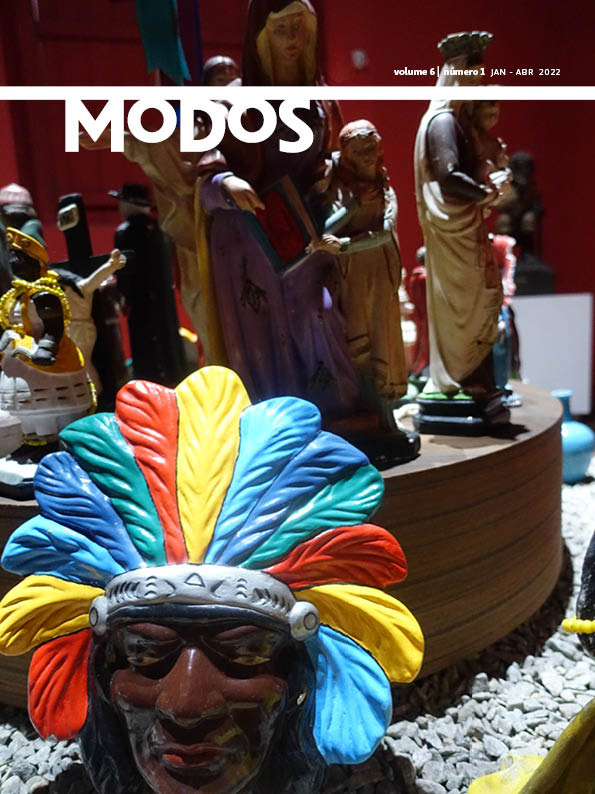Abstract
Between the 1940s and 1960s, artists Dimitri Ismailovitch and Maria Margarida Soutello, both European immigrants to Brazil, produced together a series of works representing black figures or dealing with themes related to Afro-Brazilian identity. The present article examines that output and discusses its early reception, with the objective of understanding how it was viewed in the cultural context of that period. Far from qualifying their work as mere cultural appropriation, it is discussed here in terms of the concept of ‘diasporic imagination’. The central argument is that the artists’ experience of dislocation and double consciousness, characteristic of exile, channeled their gaze upon blackness towards the reinvention of identities through strategies of masquerade and mysticism. The carnivalesque aspect of Brazilian culture made it possible for that imaginary construct to prosper, constituting a social reality in its own right.
References
ANTONISCH, M. Searching for belonging – an analytical framework. Geography Compass, v.4, n. 6, p.644-659, 2010.
A VIDA SOCIAL. ISMAILOVITCH 1940. Correio da Manhã, Rio de Janeiro, p.11, 14 set. 1940.
AXEL, B. K. The diasporic imaginary. Public Culture, Durham, 14(2), p.411-428, 2002.
AYGUN, E. Dimitri Ismailovitch, Metromod Archive, Ludwig-Maximilians-Universität, Munique, Alemanha; METROMOD, Public Interface, METROMOD Archive, 2021.
CAMPOS, M. J. Arthur Ramos: Luz e sombra na antropologia brasileira. Uma versão da democracia racial no Brasil nas décadas de 1930 e 1940. Rio de Janeiro: Edições da Biblioteca Nacional, 2004.
CARDOSO, R. Modernity in Black and White: Art and Image, Race and Identity in Brazil, 1890-1945. Cambridge: Cambridge University Press, 2021.
CAVALCANTI, E. M. A ceia brasileira de Ismailovitch: Homenagem ao Aleijadinho. Rio de Janeiro: Museu Villa-Lobos, 2014.
CLIFFORD, J. The Predicament of Culture: Twentieth-Century Ethnography, Literature, and Art. Cambridge: Harvard University Press, 1988.
CONDURU, R. Formações transatlânticas – Mestre Didi, Martiniano do Bonfim e a arte da África no Brasil desde os oitocentos. 19&20, Rio de Janeiro, v.16, n.1, jan./jun. 2021.
CRAVEN, D. Art History as Social Praxis: the Collected Writings of David Craven [organizado por Brian Winkenweder]. Leiden: Brill, 2017.
DA RÚSSIA CZARISTA AO SOLAR DE SÃO CLEMENTE. Revista da Semana, p.9-12, 20 out. 1945.
DOGRAMACI, B.; MERSMANN, B. (orgs.). Handbook of Art and Global Migration: Theories, Practices and Challenges. Berlin: De Gruyter, 2019.
DOYLE, L.; WINKIEL, L. (orgs.). Geomodernisms: Race, Modernism, Modernity. Bloomington: Indiana University Press, 2005.
DRUMMOND DE ANDRADE, C. D. de. O pintor, a cidade, o santo. Correio da Manhã, 26/04/1964, 1º caderno, p.6.
ECKMANN, S. Exile and modernism: Theoretical and methodological reflections on the exile of artists in the 1930s and 1940s. Stedelijk Studies, Amsterdam, n.9, p1-14, fall 2019.
FLUSSER, V. In: FINGER, A. (org.). The Freedom of the Migrant: Objections to Nationalism [traduzido por Kenneth Kronenberg]. Urbana: University of Illinois Press, 2003.
FREEDBERG, D. The Power of Images: Studies in the History and Theory of Response. Chicago: University of Chicago Press, 1989.
GELL, A. Art and Agency: an Anthropological Theory. Oxford: Clarendon, 1998.
GILROY, P. The Black Atlantic: Modernity and Double Consciousness. London: Verso, 1993.
GOMES DA CUNHA, O. M. Sua alma em sua palma: Identificando a ‘raça’ e inventando a nação. In: PANDOLFI, D. (org.). Repensando o Estado Novo. Rio de Janeiro: Fundação Getúlio Vargas, 1999.
HILLER, S. (org.). The Myth of Primitivism: Perspectives on Art. London: Routledge, 1991.
ITZIGSOHN, J.; BROWN, K. L. The Sociology of W.E.B. Du Bois: Racialized Modernity and the Global Color Line. New Yook: New York University Press, 2020.
LIMA, H. Alvarus e seus bonecos. Rio de Janeiro: Ministério da Educação e Cultura, 1954.
LIRA NETO. Uma história do samba: Volume I (as origens). São Paulo: Companhia das Letras, 2017.
MACEDO, D. de. A pintora Maria Margarida. Ocidente. Revista Portuguesa Mensal, Lisboa, v.42, n.165/170, p.252-256, 1952.
MISHRA, V. The diasporic imaginary: Theorizing the Indian diaspora. Textual Practice, 10(3), p.421-447, 1996.
MITTER, P. Decentering modernism: Art history and avant-garde art from the periphery. The Art Bulletin, New York, n.90, p.531-548, 2008.
MOREL, M. M. Eu pintei o anjo negro. Revista da Semana, Rio de Janeiro, p.46, 30 maio 1953.
OGUIBE, O. Exile and the creative imagination. Portal. Journal of Multidisciplinary International Studies, Sydney, v.2, n.1, p.1-17, 2005.
PAPASTERGIADIS, N. Modernity as Exile: the Stranger in John Berger’s Writing. Manchester: Manchester University Press, 1993.
PAZ, E. A. Sôdade do cordão. Rio de Janeiro: ELF/Fundação Universitária José Bonifácio, 2000.
QUAYSON, A.; DASWANI, G. (orgs.). A Companion to Diaspora and Transnationalism. Oxford: Wiley-Blackwell, 2013.
RAMOS, A. Introdução à antropologia brasileira. 2º volume. As culturas européias e os contatos raciais e culturais. Rio de Janeiro: Casa do Estudante do Brasil, 1947.
ROGERS, R. A. From cultural exchange to transculturation: A review and reconceptualization of cultural appropriation. Communication Theory, Oxford, v.16, n.4, p.474-503, nov. 2006.
SAID, E. W. Reflections on Exile and other Literary and Cultural Essays. London: Granta, 2001.
SCHNEIDER, A. On ‘appropriation’: A critical reappraisal of the concept and its application in global art practices. Social Anthropology, v.11, n.2, p.215-229, 2003.
SEIDEL, M. Exile and the Narrative Imagination. New Haven: Yale University Press, 1986.
SGARBI, O. A nacionalisação da arte. Vida Doméstica, Rio de Janeiro, s.p., abr. 1938.
SMITH, T. L. Brazil: People and Institutions. Baton Rouge: Louisiana State University Press, 1954.
STAM, R.; SHOHAT, E. Race in Translation: Culture Wars around the Postcolonial Atlantic. New York: New York University Press, 2012.
TEIXEIRA LEITE, J. R. Literatura e arte. Revista da Semana, Rio de Janeiro, p.6, 12 out. 1957.
TORGOVNICK, M. Gone Primitive: Savage Intellects, Modern Lives. Chicago: University of Chicago Press, 1990.
VALLE, A. Arte sacra afrobrasileira na imprensa: Alguns registros pioneiros, 1904-1932. 19&20, 13(1), 2018.
YOUNG, J. O.; BRUNK, C. G. (orgs.). The Ethics of Cultural Appropriation. Oxford: Wiley-Blackwell, 2012.
ZIFF, B.; RAO, P. V. (orgs.). Borrowed Power: Essays on Cultural Appropriation. New Brunswick: Rutgers University Press, 1997.

This work is licensed under a Creative Commons Attribution-NonCommercial-ShareAlike 4.0 International License.
Copyright (c) 2022 Rafael Cardoso

